Machine-Learning-Assisted Composition Design for High-Yield-Strength TWIP Steel
Abstract
:1. Introduction
2. Materials and Methods
2.1. Machine Learning Strategy for High-Yield-Strength TWIP Steel
2.2. Data Preparation and Processing
2.3. SHAP Analytical and Element Selection
2.4. Multi-Objective Optimization
2.5. Experimental Methods
3. Results
3.1. Dataset Distribution Analysis
3.2. Machine Learning Algorithm Selection
3.3. Design of High-Yield-Strength TWIP Steel
3.4. Microstructure Analysis
3.5. Analysis of Model Effectiveness
4. Conclusions
Supplementary Materials
Author Contributions
Funding
Data Availability Statement
Acknowledgments
Conflicts of Interest
References
- De Cooman, B.C.; Estrin, Y.; Kim, S.K. Twinning-induced plasticity (TWIP) steels. Acta Mater. 2018, 142, 283–362. [Google Scholar] [CrossRef]
- Yang, G.-H.; Kim, J.-K. An overview of high yield strength twinning-induced plasticity steels. Metals 2021, 11, 124. [Google Scholar] [CrossRef]
- Bastidas, D.M.; Ress, J.; Bosch, J.; Martin, U. Corrosion Mechanisms of High-Mn Twinning-Induced Plasticity (TWIP) Steels: A Critical Review. Metals 2021, 11, 287. [Google Scholar] [CrossRef]
- Sugimoto, K.; Hojo, T.; Srivastava, A.K. Low and Medium Carbon Advanced High-Strength Forging Steels for Automotive Applications. Metals 2019, 9, 1263. [Google Scholar] [CrossRef]
- Dini, G.; Najafizadeh, A.; Ueji, R.; Monir-Vaghefi, S.M. Improved tensile properties of partially recrystallized submicron grained TWIP steel. Mater. Lett. 2010, 64, 15–18. [Google Scholar] [CrossRef]
- Dini, G.; Najafizadeh, A.; Ueji, R.; Monir-Vaghefi, S.M. Tensile deformation behavior of high manganese austenitic steel: The role of grain size. Mater. Des. 2010, 31, 3395–3402. [Google Scholar] [CrossRef]
- Kang, S.; Jung, J.-G.; Kang, M.-H.; Woo, W.; Lee, Y.-K. The effects of grain size on yielding, strain hardening, and mechanical twinning in Fe-18Mn-0.6C-1.5Al twinning-induced plasticity steel. Mater. Sci. Eng. A 2016, 652, 212–220. [Google Scholar] [CrossRef]
- Gutierrez-Urrutia, I.; Raabe, D. Grain size effect on strain hardening in twinning-induced plasticity steels. Scr. Mater. 2012, 66, 992–996. [Google Scholar] [CrossRef]
- Li, D.-D.; Qian, L.-H.; Wei, C.-Z.; Liu, S.; Zhang, F.-C.; Meng, J.-Y. The tensile properties and microstructure evolution of cold-rolled Fe-Mn-C TWIP steels with different carbon contents. Mater. Sci. Eng. A 2022, 839, 142862. [Google Scholar] [CrossRef]
- Li, S.-H.; Wang, X.-L.; Chen, C.-F. Effect of annealing temperature on carbide precipitation, microstructure and mechanical properties of Fe-Mn-C- (Cr, Mo, W, Ni, Nb, Ti, V) multi-alloying TWIP steel. Mater. Today Commun. 2024, 39, 108895. [Google Scholar] [CrossRef]
- Hamada, A.; Kömi, J. Effect of microstructure on mechanical properties of a novel high-Mn TWIP stainless steel bearing vanadium. Mater. Sci. Eng. A 2018, 718, 301–304. [Google Scholar] [CrossRef]
- Lan, F.; Du, W.; Zhuang, C.; Li, C. Effect of niobium on inclusions in Fe-Mn-C-Al twinning-induced plasticity steel. Metals 2021, 11, 83. [Google Scholar] [CrossRef]
- Lee, S.G.; Kim, B.; Jo, M.C. Effects of Cr addition on Charpy impact energy in austenitic 0.45C-24Mn-(0,3,6)Cr steels. J. Mater. Sci. Technol. 2020, 50, 21–30. [Google Scholar] [CrossRef]
- Wang, X.-J.; Sun, X.-J.; Song, C.-W. Evolution of microstructures and mechanical properties during solution treatment of a Ti-V-Mo-containing high-manganese cryogenic steel. Mater. Charact. 2018, 135, 287–294. [Google Scholar] [CrossRef]
- Kim, B.; Lee, S.G.; Kim, D.W. Effects of Ni and Cu addition on cryogenic-temperature tensile and Charpy impact properties in austenitic 22Mn-0.45C-1Al steels. J. Alloys Compd. 2020, 815, 152407. [Google Scholar] [CrossRef]
- Gwon, H.; Kim, J.-K.; Shin, S. The effect of vanadium micro-alloying on the microstructure and the tensile behavior of TWIP steel. Mater. Sci. Eng. A 2017, 696, 416–428. [Google Scholar] [CrossRef]
- Li, D.-J.; Feng, Y.-R.; Song, S.-Y. Influences of Nb-microalloying on microstructure and mechanical properties of Fe-25Mn-3Si-3Al TWIP steel. Mater. Des. 2015, 84, 238–244. [Google Scholar] [CrossRef]
- Wang, X.-J.; Sun, X.-J.; Song, C. Enhancement of yield strength by chromium/nitrogen alloying in high-manganese cryogenic steel. Mater. Sci. Eng. A 2017, 698, 110–116. [Google Scholar] [CrossRef]
- Tang, L.; Jiang, F.-Q.; Liu, H.-B. In situ neutron diffraction reveals the effect of Cu micro-alloying on low-temperature tensile properties of TWIP steels. Mater. Sci. Eng. A 2022, 845, 143211. [Google Scholar] [CrossRef]
- Jin, J.-E.; Lee, Y.-K. Effects of Al on microstructure and tensile properties of C-bearing high Mn TWIP steel. Acta Mater. 2012, 60, 1680–1688. [Google Scholar] [CrossRef]
- Pattanayak, S.; Dey, S.; Chatterjee, S.; Chowdhury, S.G.; Datta, S.P. Computational intelligence based designing of microalloyed pipeline steel. Comput. Mater. Sci. 2015, 104, 60–68. [Google Scholar] [CrossRef]
- Reddy, N.S.; Krishnaiah, J.; Young, H.B. Design of medium carbon steels by computational intelligence techniques. Comput. Mater. Sci. 2015, 101, 120–126. [Google Scholar] [CrossRef]
- Lee, J.-Y.; Kim, M.; Lee, Y.-K. Design of high strength medium-Mn steel using machine learning. Mater. Sci. Eng. A 2022, 843, 143148. [Google Scholar] [CrossRef]
- Seghier, M.E.A.B.; Gao, X.-Z.; Jafari-Asl, J.; Thai, D.K. Modeling the nonlinear behavior of ACC for SCFST columns using experimental-data and a novel evolutionary-algorithm. Structures 2021, 30, 692–709. [Google Scholar] [CrossRef]
- Seghier, M.E.A.B.; Kechtegar, B.; Amar, M.N. Simulation of the ultimate conditions of fibre-reinforced polymer confined concrete using hybrid intelligence models. Eng. Fail. Anal. 2021, 128, 105605. [Google Scholar] [CrossRef]
- Jiang, L.; Fu, H.-D.; Zhang, Z.-H.; Zhang, H.-T. Synchronously enhancing the strength, toughness, and stress corrosion resistance of high-end aluminum alloys via interpretable machine learning. Acta Mater. 2024, 270, 119873. [Google Scholar] [CrossRef]
- Jiang, L.; Wang, C.-S.; Fu, H.-D. Discovery of aluminum alloys with ultra-strength and high-toughness via a property-oriented design strategy. J. Mater. Sci. Technol. 2022, 98, 33–43. [Google Scholar] [CrossRef]
- Zhang, Z.-H.; Fu, H.-D.; Zhu, S.-C.; Yong, W. Machine learning assisted composition effective design for precipitation strengthened copper alloys. Acta Mater. 2021, 215, 117118. [Google Scholar] [CrossRef]
- Zhang, Z.-H.; Fu, H.-D.; He, X.-Q. Dramatically enhanced combination of ultimate tensile strength and electric conductivity of alloys via machine learning screening. Acta Mater. 2020, 200, 803–810. [Google Scholar] [CrossRef]
- Ruan, J.-J.; Xu, W.-W.; Yang, T.-R. Accelerated design of novel W-free high-strength Co-base superalloys with extremely wide γ/γʹ region by machine learning and CALPHAD methods. Acta Mater. 2020, 186, 425–433. [Google Scholar] [CrossRef]
- Xiong, J.; Shi, S.-Q.; Zhang, T.-Y. A machine-learning approach to predicting and understanding the properties of amorphous metallic alloys. Mater. Des. 2020, 187, 108378. [Google Scholar] [CrossRef]
- Yang, H.-K.; Zhang, Z.-J.; Dong, F.-Y. Strain rate effects on tensile deformation behaviors for Fe-22Mn-0.6 C-(1.5 Al) twinning-induced plasticity steel. Mater. Sci. Eng. A 2014, 607, 551–558. [Google Scholar] [CrossRef]
- Sun, S.-H.; Xue, Z.-Y. Effect of Aging Process on the Strain Rate Sensitivity in V-Containing TWIP Steel. Metals 2021, 11, 126. [Google Scholar] [CrossRef]
- Seghier, M.E.A.B.; Plevris, V.; Solorzano, G. Random forest-based algorithms for accurate evaluation of ultimate bending capacity of steel tubes. Structures 2022, 44, 261–273. [Google Scholar] [CrossRef]
- Lundberg, S.M.; Lee, S.I. A unified approach to interpreting model predictions. Adv. Neural Inf. Process. Syst. 2017, 30, 4768–4777. [Google Scholar]
- Shi, B.F.; Lookman, T.; Xue, D.-Z. Multi-objective optimization and its application in materials science. Mater. Genome Eng. Adv. 2023, 1, e14. [Google Scholar] [CrossRef]
- Chen, Y.-F.; Tian, Y.; Zhou, Y.-M. Machine learning assisted multi-objective optimization for materials processing parameters: A case study in Mg alloy. J. Alloys Compd. 2020, 844, 156159. [Google Scholar] [CrossRef]
- Scott, C.; Remy, B.; Collet, J.L. Precipitation strengthening in high manganese austenitic TWIP steels. Int. J. Mater. Res. 2011, 102, 538–549. [Google Scholar] [CrossRef]
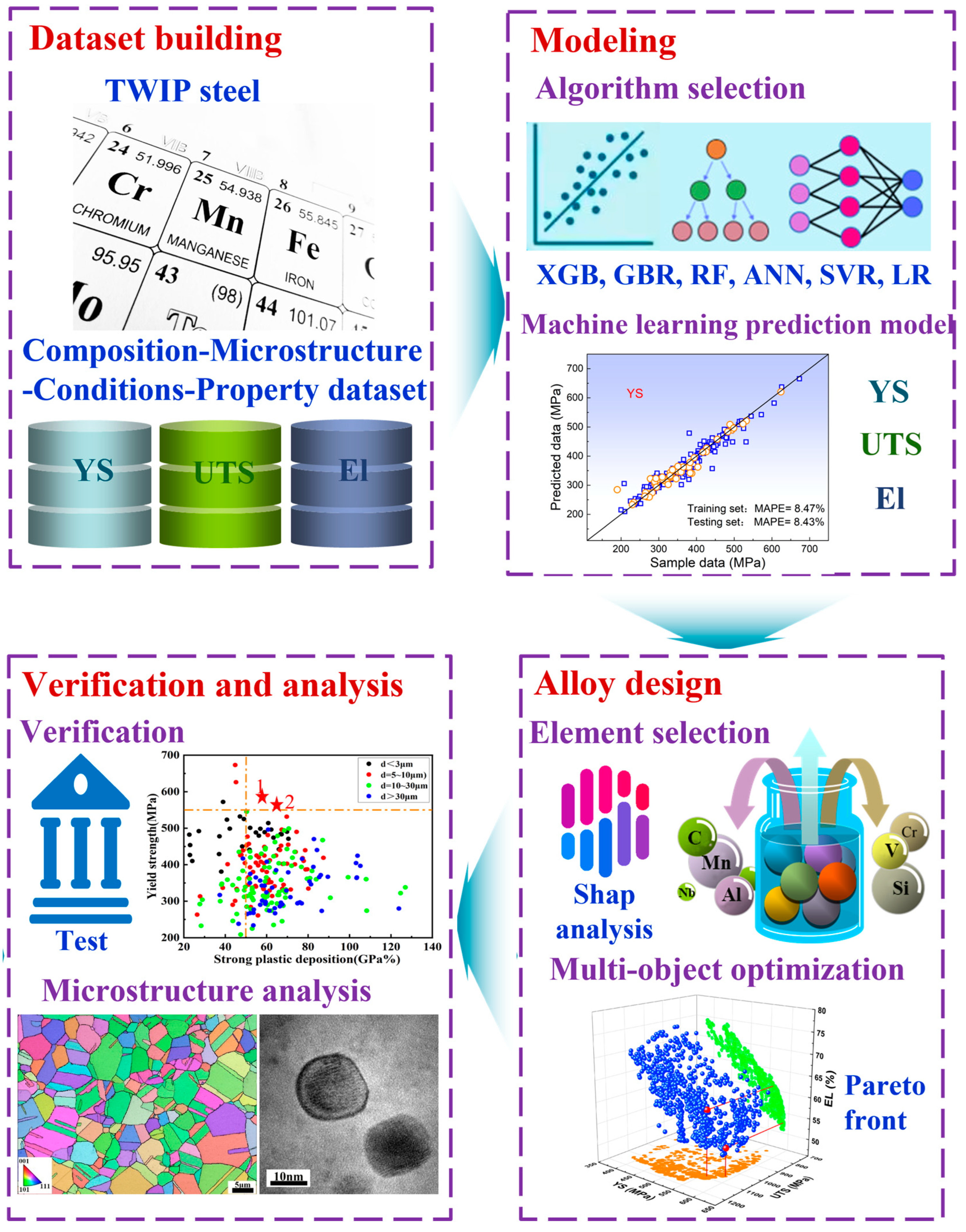
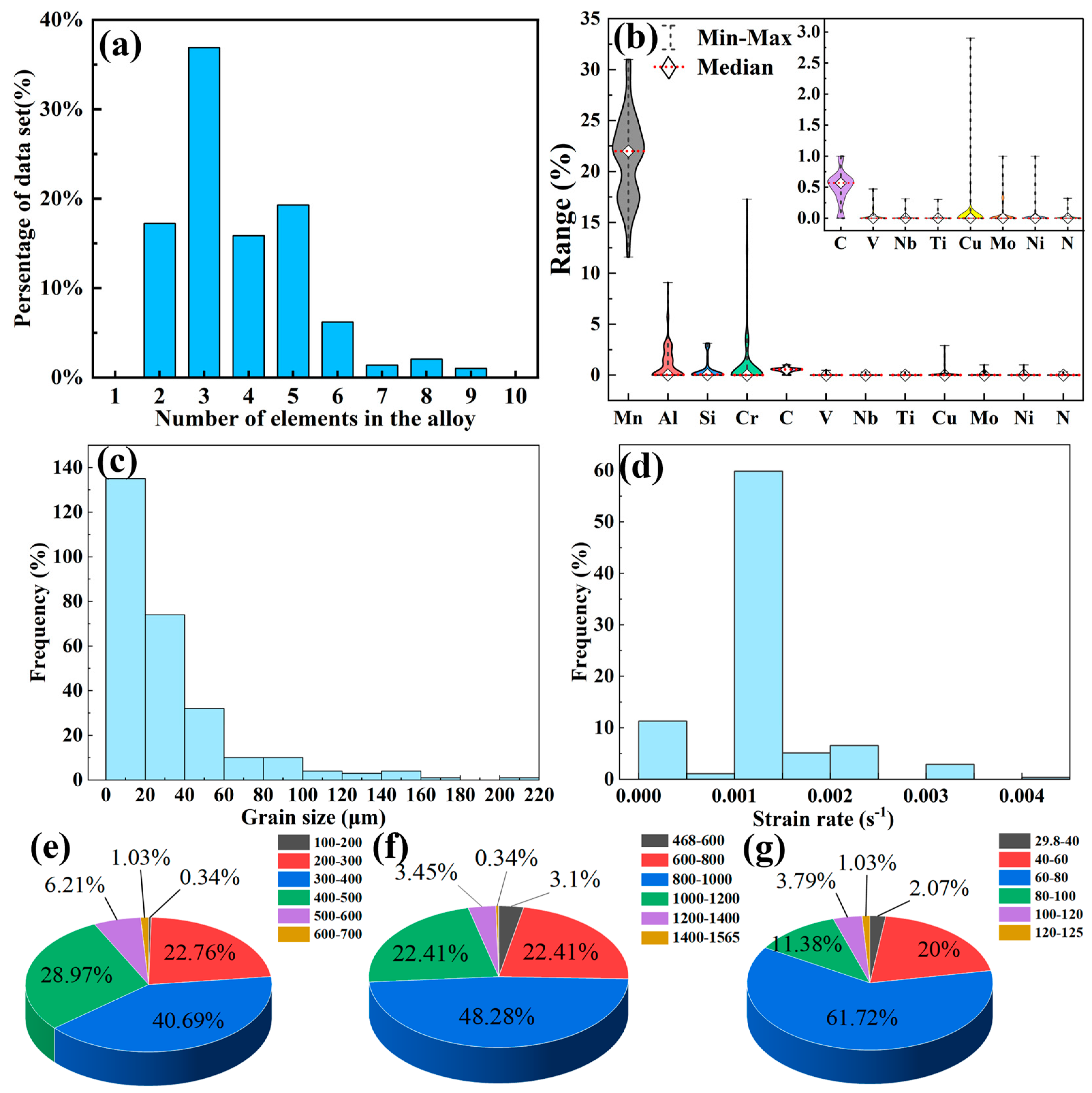
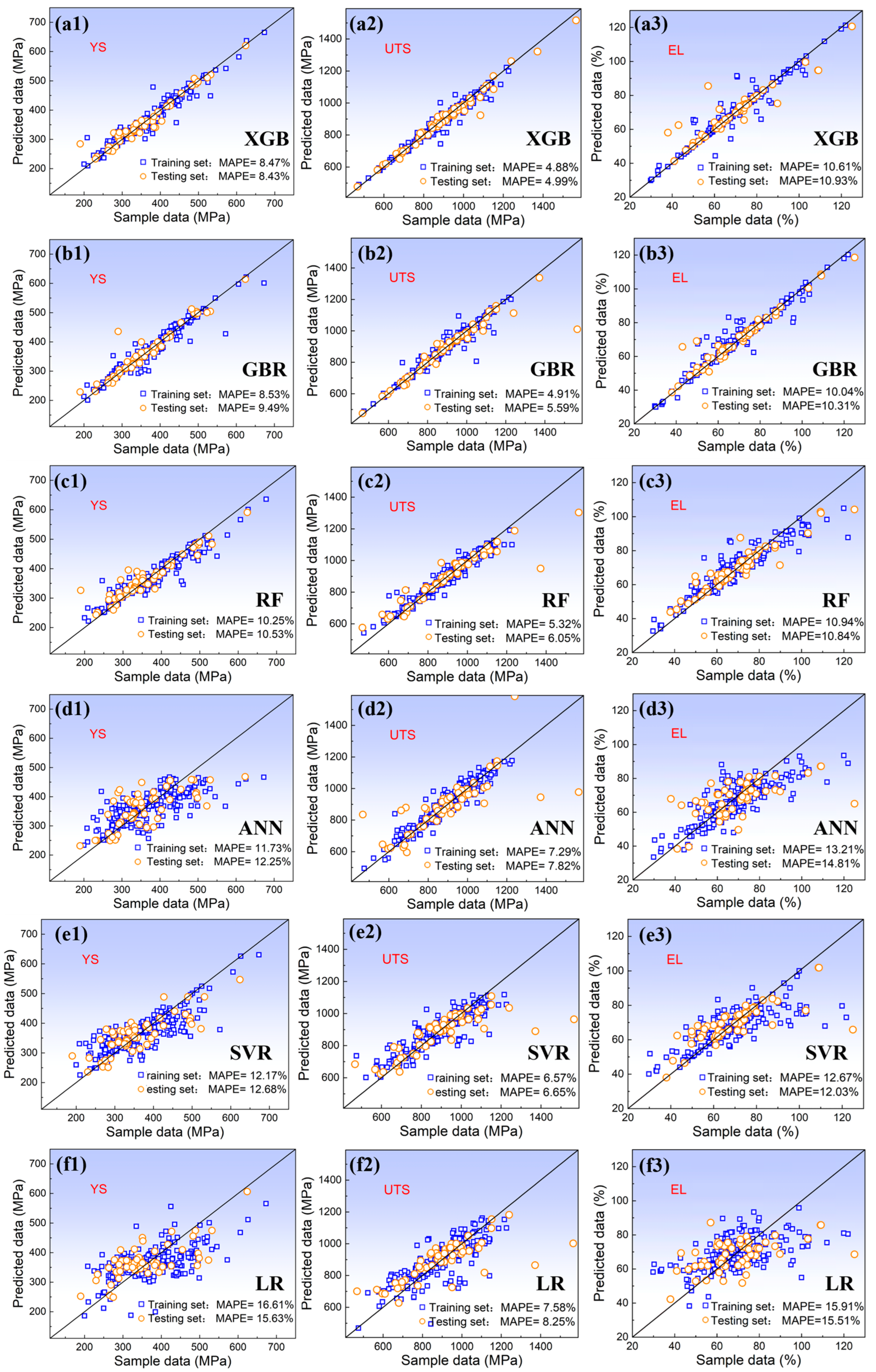
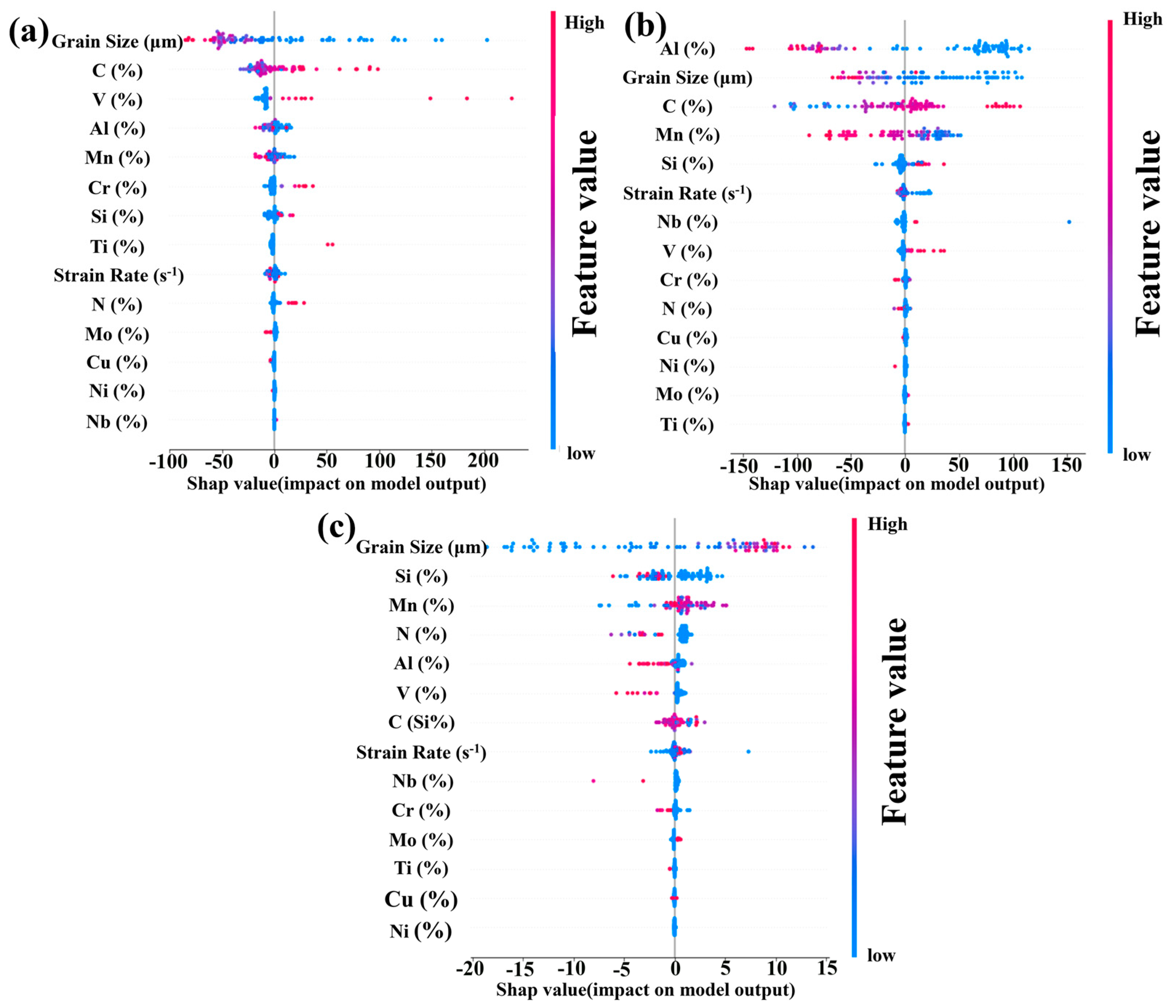
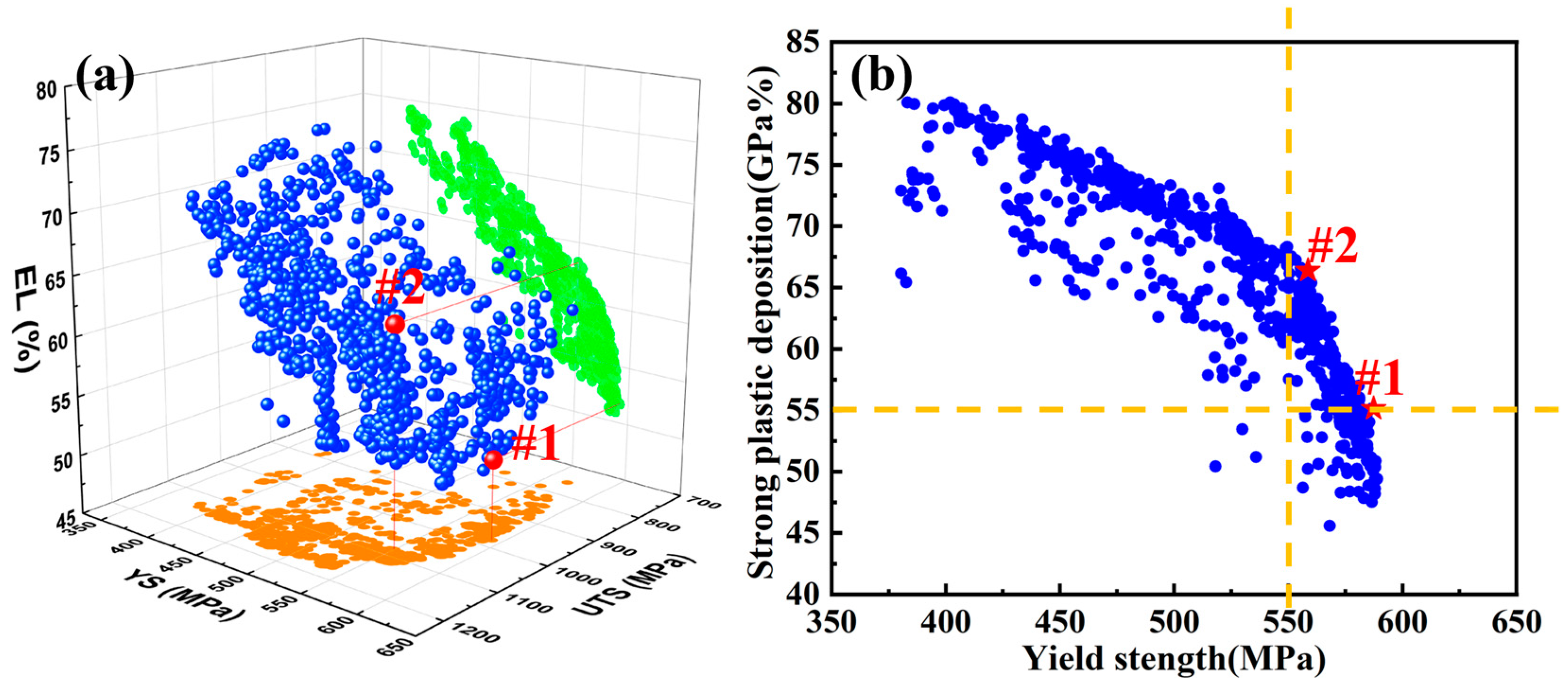
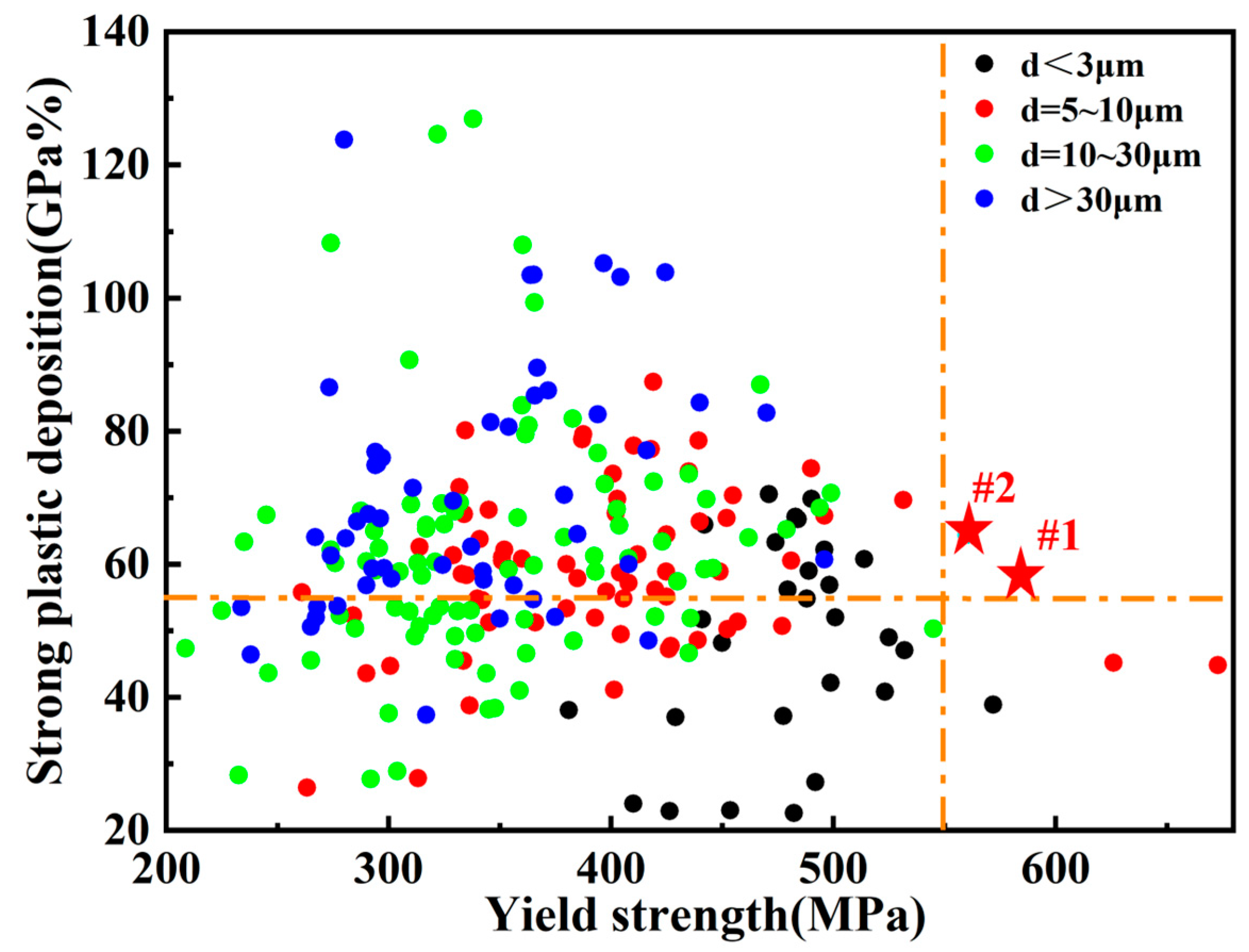

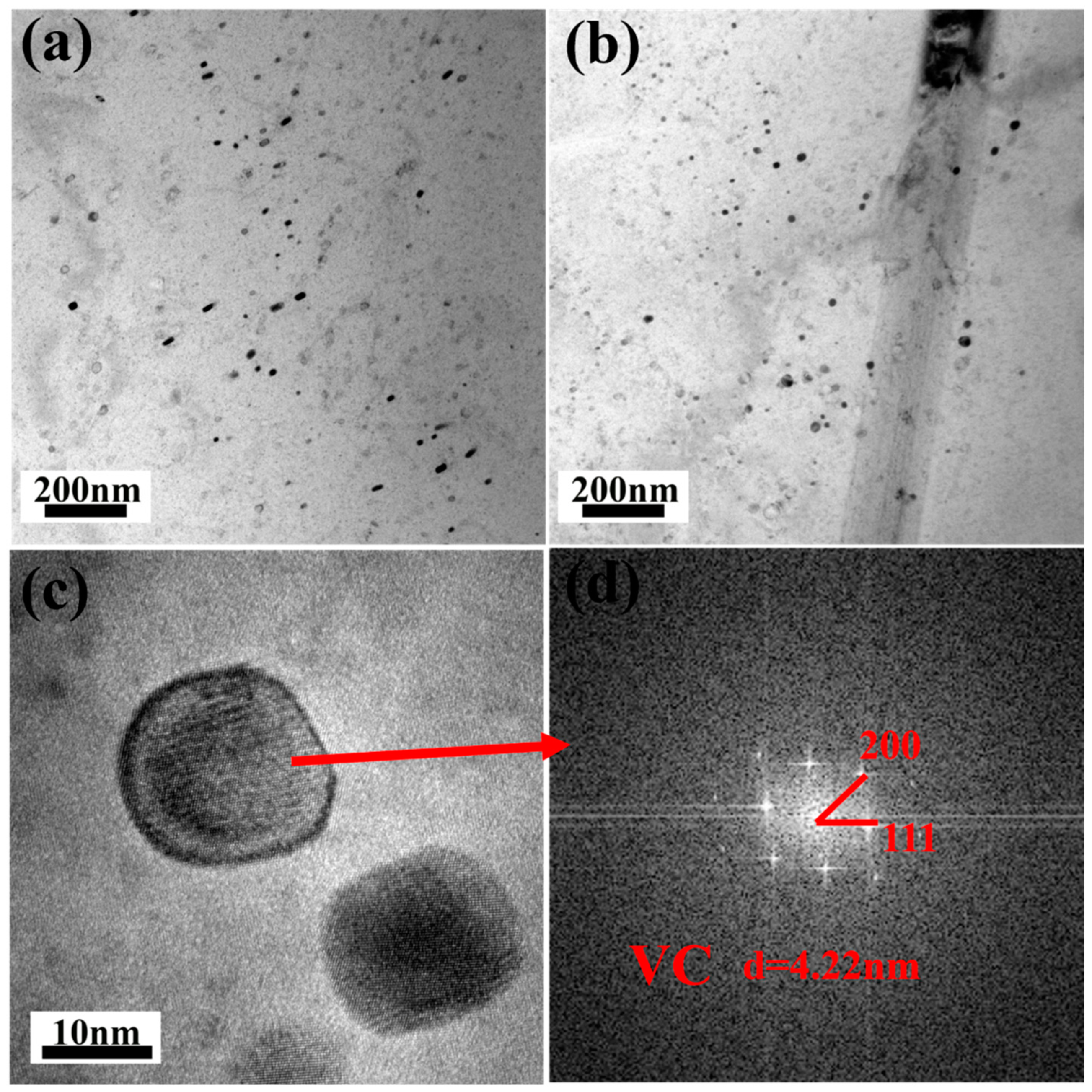

| Mass Fraction of Element/wt.% | d /μm | V /s−1 | ||||||||||||
|---|---|---|---|---|---|---|---|---|---|---|---|---|---|---|
| Mn | C | Al | Si | Cr | V | Nb | Ti | Cu | Mo | Ni | N | |||
| Lower limit | 0 | 0 | 0 | 0 | 0 | 0 | 0 | 0 | 0 | 0 | 0 | 0 | 10 | 0.001 |
| Upper limit | 30 | 1 | 3 | 3 | 4 | 0.5 | 0.3 | 0.1 | 0 | 0 | 0 | 0 | 10 | 0.001 |
| Mass Fraction of Element/wt.% | d /μm | V /s−1 | YS /MPa | UTS /MPa | EL /% | SPD (GPa%) | |||||||||
|---|---|---|---|---|---|---|---|---|---|---|---|---|---|---|---|
| Mn | C | Al | Si | Cr | V | Nb | Ti | ||||||||
| #1 | Pre | 15.84 | 0.68 | 2.38 | 2.05 | 1.86 | 0.49 | 0.30 | 0.05 | 10 | 0.001 | 593 | 1050 | 52.5 | 55.1 |
| Exp | 16.02 | 0.66 | 2.28 | 1.98 | 1.84 | 0.48 | 0.28 | 0.06 | 10.41 | 0.001 | 585 ± 6.3 | 1055 ± 5.7 | 55.1± | 58.1 | |
| #2 | Pre | 16.88 | 0.74 | 1.71 | 1.70 | 1.15 | 0.47 | 0.01 | 0.05 | 10 | 0.001 | 553 | 1091 | 60.9 | 66.4 |
| Exp | 17.05 | 0.78 | 1.65 | 1.68 | 1.20 | 0.45 | 0.01 | 0.06 | 10.32 | 0.001 | 560 ± 7.3 | 1101 ± 8.8 | 58.5 ± 2.2 | 64.4 | |
Disclaimer/Publisher’s Note: The statements, opinions and data contained in all publications are solely those of the individual author(s) and contributor(s) and not of MDPI and/or the editor(s). MDPI and/or the editor(s) disclaim responsibility for any injury to people or property resulting from any ideas, methods, instructions or products referred to in the content. |
© 2024 by the authors. Licensee MDPI, Basel, Switzerland. This article is an open access article distributed under the terms and conditions of the Creative Commons Attribution (CC BY) license (https://creativecommons.org/licenses/by/4.0/).
Share and Cite
Zhou, X.; Xu, J.; Meng, L.; Wang, W.; Zhang, N.; Jiang, L. Machine-Learning-Assisted Composition Design for High-Yield-Strength TWIP Steel. Metals 2024, 14, 952. https://doi.org/10.3390/met14080952
Zhou X, Xu J, Meng L, Wang W, Zhang N, Jiang L. Machine-Learning-Assisted Composition Design for High-Yield-Strength TWIP Steel. Metals. 2024; 14(8):952. https://doi.org/10.3390/met14080952
Chicago/Turabian StyleZhou, Xiaozhou, Jiangjie Xu, Li Meng, Wenshan Wang, Ning Zhang, and Lei Jiang. 2024. "Machine-Learning-Assisted Composition Design for High-Yield-Strength TWIP Steel" Metals 14, no. 8: 952. https://doi.org/10.3390/met14080952






